|
|
|---|---|
Edition 76- December 2014 Published at Quepos, Canton of Aguirre, Province of Puntarenas, Costa Rica (© Copyright 2014 - All Rights Reserved) |
Broken News
(All the News That's Fit to Reprint)
Quepos Marina Slowly Growing
The marina in Quepos, officially known as Marina Pez Vela, had been conceived over many years and finally began to be constructed in 2007. Unfortunately, the next year was the collapse of the U.S. mortgage market that led to the recession we're still struggling to get out of. The downturn probably arrived in Costa Rica a year later as most economic things here lag the U.S. economy.
 |
Original Pez Vela Concept |
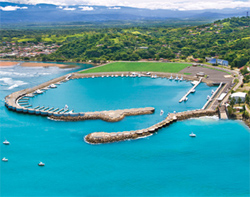 |
Phase One Opened in 2010 |
Originally, this large project envisioned the eventual construction of 308 slips, boutique hotels, over 200 condominiums and a variety of shops and stores (see original artists's conception right). The recession put a crimp in that plan or at least in the timeline. When Phase I opened in 2010 it was a very reduced version of the original total plan with about 100 slips and no commercial facilities.
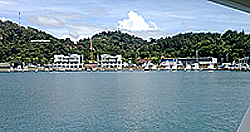 |
New Restaurants and Shops Have Been Added |
 |
More Boats in the Slips Now |
A couple of years later, the build-out on the shore side of the marina began with the construction of the buildings now housing two restaurants and a number of offices and shops (see photo left).
The other thing GG noticed on his latest visit was the increased number of boats (sorry, yachts) parked in the current slips that ring the man-made bay. Compare the picture left with the relatively sparse population of boats in the picture at right which is when Phase One was completed in 2010.
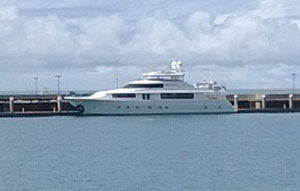 |
The 112 Foot Westport "Boat" |
GG was invited by a visitor friend to see one of the yachts he manages that is currently moored at the marina. This beautiful ship, a 112 foot Westport shown at right, was the vantage point from which I took the inside marina photos above, left.
So it was good to see that progress is being made at Marina Pez Vela, even if it's slower than the original plan. One of the two restaurants mentioned above was the El Gran Escape (recently it changed its name to the Runaway Grill) that had been an icon in downtown Quepos for years. The ROMEOs reviewed the new location in December of 2013; to see that review go here: El Gran Escape (at Sunset Place)
While the marina was growing slowly, some of our Quepos food purveyors were breaking out on their own.
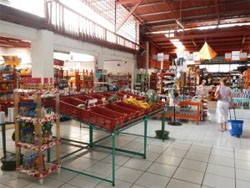 |
GG Misses the Old Super Mas |
Some readers may remember GG grieving over the loss of his favorite Quepos supermarket back in the November 2013 issue (see Super Mas No Mas). I loved that market, it had more items that gringos are addicted to crammed into its limited shelf space than any other place in town. Also, I was on a personal basis with many of the friendly staff (see Super Mas Rules!). These days, I still see one former Super Mas dude at the futsal on futbol evenings; he's quite a good portero (goalie). I love this small town stuff.
By Norteamericano standards what we call a "Supermarket" here, or "Super" for short (short for Super Mercado that is), is not much more in size than a large 7-11 in the states. But when you live in a small town in a relatively rural part of the world, these stores take on a more elevated and personal status. Part of the routine of a retired dude is a trip to the market nearly every day for whatever incidentals are currently lacking at home.
There are four Super Mercados worth visiting in the Quepos town limits, all of them are within three blocks of GG's apartment. The first is Pali, a Walmart property with a chain of stores throughout Central America. Not my favorite place because of its limited selection. I used to quip that Pali had three times the floor space of Super Mas but half the selection. And their damn bagging policy is irritating, i.e., they charge 10 colones (less than two cents U.S.) for a plastic bag and then you have to bag it yourself anyway. I go there usually on Sundays but only to pick up a half dozen large, juicy, sweet Chliean oranges that can't be found anywhere else in Quepos.
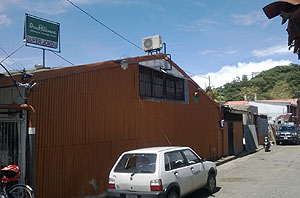 |
Jordix is Expanding Out the Back |
Now for the good news. The other three Supers (Super Jordix, Super 2000 and PriceSmart, also known as Mini Price), all Tico-owned properties, are simultaneously expanding as I write.
Super Jordix is a small but quite busy market just two blocks from my house that is super convenient for me as it's on the way to or from the bus station and also is midway to the futsal (futbol games always go better with a Dos Pinos ice cream sandwich - always in stock at Jordix). The other advantage with Super Jordix is that it's open from 6 in the morning to 10 at night, 364 days per year (closed Christmas day). That's about as close to gringo 7-11 hours as it gets here. Jordix is expanding out the back of the existing store because it's flanked on one side by an alley and on the other by an expensive private home.
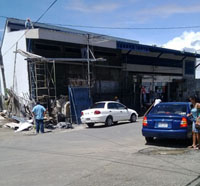 |
Super 2000 Expansion |
Then there's Super 2000, also located about three blocks from GG's apartment, on the way to the Boca Vieja district. This expansion has been underway for some time and may be the first to be finished. The size of the new section (left side in the photo to the left) implies at least a doubling of the store is currently in process.
Super 2000 has all the basics including meat and produce departments but very little in the way of gringo products; perhaps they will add these in the expanded facility. They do a good job of using the limited space they have but still operate with some of the old world techniques, such as having to weigh produce in the produce area because there are no scales at the registers.
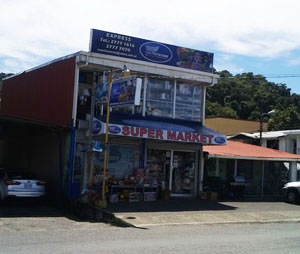 |
PriceSmart As It Is Today |
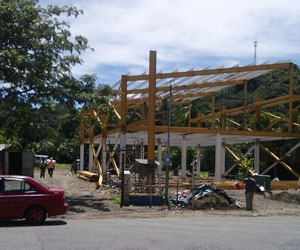 |
The New PriceSmart Under Construction |
Despite some drawbacks GG found himself frequenting Super 2000 more frequently after the demise of Super Mas. Actually, it took shopping at three markets fairly regularly to replace Super Mas. Those three would be Super 2000, Pali and PriceSmart (Jordix is simply a convenience for me for small items).
The most interesting of the surviving markets to me is PriceSmart. This market is situated only two blocks from my apartment but, more importantly, as I went their more often and rummaged through the shelves, I began to discover more and more of those ex-pat products that can't be found in other parts of Quepoland. I learned later one reason why these products, things like Vlassic Dill Pickles and large bricks of Wisconsin cheddar cheese, are there and nowhere else in Quepos. Though the store is privately owned, they have a distributor agreement with PriceSmart-Costa Rica which is a division of Costco (dude! this portends well for the expanded market).
I got to meet the owner of PriceSmart, Emilio, a very personable and hard working gent who's almost always there. I also became friendly with the staff similar to the camaraderie I had with the Super Mas staff except the PS dudes call me "cachete" (literally translated as "chubby cheeks" - see What's-in-a-Word below) whereas the Super Mas boys and girls called me Bob Esponja (Sponge Bob). What can I say...
One day after learning that the store would be expanded, I asked Emilio if his current store was about 100 square meters (about 1100 square feet) in floor space (once an engineer, always an engineer). He was surprised and said I was right on the money. "What's the new store going to be, amigo?", says I. He smiles and says proudly "495", that's over 5200 square feet and almost five times the size of the current one. It will also have verdeduria (produce), carneceria (meat) and panaderia (bakery) departments.
I know you norteamericano dudes, who have access to 30,000 and 40,000 square feet and even larger supermarkets and hypermarkets think this is much ado about nothing, but to we colonials this is real progress.
Go for it Emilio, bring it on amigo!
Rumble Talk
(Shaky Happenings On or About the Pacific Rim)
More on Predicting Tremors
Worldwide in the last decade there have been 18 earthquakes over 8.0 in Richter magnitude (too see how powerful these are, go here: Richter Scale Explained). That number of quakes of that huge magnitude is twice the number of that size that were reported in the entire 20th century.
Tropical Bird
of the Month |
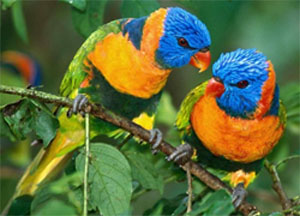 |
"What a Lovely Hue You Throw My Dear" |
Over the last several decades scientists have developed a better comprehension of how earthquakes happen and fault lines propagate but true predictability, i.e., warnings more than 30 seconds to a minute, is still elusive. They're also getting better at measuring existing strain at the faults which can tell them where major quakes might occur, if not when.
There are two areas in the western hemisphere that have demonstrated both a history of super-quakes and a long lapse in their occurrence. They are the Cascadia region of the Pacific northwest, where a superquake is be lived to have occurred in 1700 and the other off the coast of Chile where a quake in 1877 killed 2,500. I'm no geologist but it would seem to me that predicting when two countervailing, non-homogenous solids floating over a bed of molten rock actually slip might be a difficult task.
I think that's enough bloviation for now from an engineer trying to act like a vulcanologist about predicting rumbling. Until they get it right, we'll have to just watch and wait.
Turrialba Re-asserting Itself
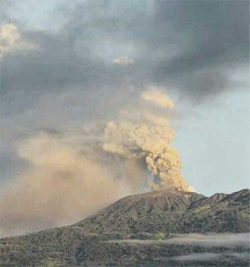 |
| Turrialba Spewing Ash |
While Arenal, our favorite volcano for tourists to see activity, has been relatively quiet for some months now, another favorite, Turrialba, has been more active lately. Turrialba is located some 135 kilometers (80 miles) southeast of Arenal as the macaw flies (but only 35 k or 20 miles east of San José). People are now prohibited within a radius of 6 kilometers of the funnel.
In recent weeks Turrialba has begun to issue substantial amounts of ash, as seen in the photo to the right, and has caused evacuations of people in the vicinity as well as considerable dusting of ash up as much as 30 k away, including the central valley and the capital.
The bulk of the emissions from the volcano have been gas and water vapor. Vulcanologists at the Costa Rica Observatorio de Sismológico y Vulcanología say they have indications that some of the material being emitted is new, meaning that new magma may be coming closer to the service. This means in turn an increased potential for a major eruption.
But here too, we can only wait and see, and hope it doesn't get more serious. This is what it means to live on the Rim.
| Check Out Recent Earthquakes Around the World Posted by the U.S. Geodetic Survey: Today's Quakes |
|---|
A Brief History of Argentina
(Part 3 - The Modern Era, 1816 to Present)
This is the third and last part of a series about the history of Argentina prompted by a three-week visit to a friend in Buenos Aires. To see the first two parts go here: Part 1 - The Pre-Columbian Period, Prior to 1500 and Part 2 - The Columbian Period, 1500 to 1816.
To cover the almost 200 years of modern Argentine history in a short writing is difficult but we'll do our best (once again, GG uses the royal "we"; thinking it appropriate in view of the nature of the following).
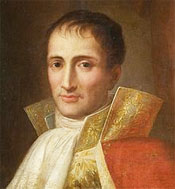 |
Spanish King Joe Bonaparte - Thanks Bro |
During the first quarter of the 19th century virtually all the Spanish colonies in the Americas from Mexico to Argentina declared themselves independent of the mother country. Likewise Brazil declared its independence from Portugal in 1822. The Spanish Colonies, from Mexico to Argentina, were encouraged in this boldness by financial problems in mother Spain caused by heavy losses like the Spanish Armada defeat in the battle of Trafalgar where the British destroyed 19 of 33 Spanish ships in October of 1805).
Napoleon's armies then entered parts of Spain under the pretext of joining Spain in a joint invasion of Portugal. With his troops handy, Napoleon proceeded to force Ferdinand VII of Spain to abdicate in favor of Nappy's brother Joseph and the Spanish court's attention was diverted from their colonies by more pressing issues at home like how do they deal with Joseph Bonaparte. Although the "new" Spain would try to retain or regain it's holdings worldwide, as would France and England, there were too many fronts to fight on at too great a distance to be effective in the long run. The European colonial period was coming to an end.
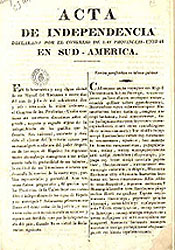 |
| Independence Act of Argentina - 1816 |
The independence process in Argentina actually started in 1810 after the deposition of the Spanish king mentioned above. Viceroy Cisneros of the The Viceroyalty of the Río de la Plata, which included both Argentina and parts of Uruguay, Paraguay and Bolivia, was overthrown resulting in this viceroyalty being the last and most short-lived viceroyalty of the Spanish Empire in the Americas. Cisneros' replacement, Carlos María de Alvear, a soldier and statesman and the so-called Supreme Director of the United Provinces of the Río de la Plata was also overthrown in 1815. He died in New York City in 1852.
In 1816, representatives of the Argentine bourgeoisie, the military and the merchants came together at the northwest town of San Miguel de Tucumán and formally declared Argentina independent from Spain. They also declared themselves to be the United Provinces of South America, which is still today one of the legal names of the Argentine Republic. The coalition was a compromise between the Unitarianists, chiefly the leaders of Buenos Aires who favored strong central government, and the Federalists who were more rural and favored a confederation of autonomous provinces. The differences between these two groups would flare up over and over again for the next 60+ years and would become known as the Argentine Civil Wars. At times these wars would even involve the French and British.
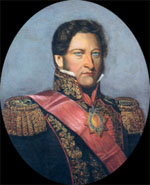 |
Caudillo Rosas |
One of the more colorful personages during this period was Juan Manuel José Domingo Ortiz de Rosas. who was Buenos Aires Provincial Governor for 27 years from 1835 to 1852. He was born in Buenos Aires into a wealthy land-owning family. As a 13-year old, Rosas served in the Argentine defense forces that repulsed the British in 1806. He later successfully repulsed the British one more time when they attacked Buenos Aires.
While Rosas originally had sympathies for the organization and order of the colonial structure, he accepted independence in 1816 and eventually changed to the Federalist party in 1826. Later he fought and won against the Unitarians and was elected "Caudillo" (leader, head) of Buenos Aires province with extraordinary powers, that is, he essentially became dictator of the province. Rosas was removed from power in 1852 and Argentina's first constitution was ratified in 1853.
During the period leading up to 1880, Argentina, despite the constitution of 1853, continued to be in a power struggle and suffered periodic armed conflict. The Argentine Internecine Wars (1814-1880) were between various provinces of the United Provinces of South America and between Unitarianists and Federalists within provinces. Although a permanent settlement would not be established at Buenos Aires until 1880, the port there continued to be an important commercial center as it could serve the various provinces of Argentina as well as Uruguay, Paraguay and even Bolivia by trans-shipping overland or up the Paraguay and Paraná rivers. The British and French would also periodically raid Buenos Aires in futile attempts to re-establish their empires.
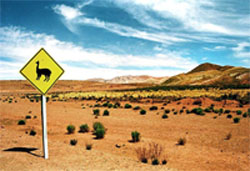 |
Llama Crossing on the Pampas |
The Argentine state and the city of Buenos Aires were finally consolidated in 1880 by creating a federal district, similar to Washington, D.C., in and around Buenos Aries and making the district the capital of the country. The period from 1880 to 1930 saw explosive growth in the country as modern agricultural techniques were introduced to a country with strong natural resources. The development of the Pampas areas surrounding Buenos Aires for export of agricultural products was further fueled by widespread immigration and investment from Europe (the Brits came in heavy for railroads and ports). Much of the immigration, particularly in the early 1900's came from Italy (my friend who lives there says that Argentines still speak Spanish with an Italian accent).
During this period, prior to the worldwide financial collapse in the late 1920's, Argentina achieved the rank of seventh richest country in the world. The Wall Street crash in the U.S. in 1929, however, had a strong negative effect on the Argentine economy as well. Unfortunately, political turmoil and financial instability in Argentina would last all the way through the 20th century and up to the present time.
By the 1900's the country had evolved politically from the Federalists and Unitarianists into the Conservatives and the Radicals. The Army backed the conservatives and did not hesitate to stage a coup when they thought it necessary. They did so in 1930 and made General Jose F. Uriburu president. He called an election for 1931 but the Radical party was not allowed to take part (selective democracy). After two additional less-than-squeaky-clean national elections, the Army staged another coup in 1943, one of the coup leaders being a gent named Juan Domingo Perón. He became the dominant national figure during this period and was elected to the presidency in 1946.
In January 1944 Argentina would sever (a little late) diplomatic relations with Germany and Japan and in March of that year they would declare war on the axis powers, about two months before VE day in Europe (seems to this reporter like a case of "cubierta sus nalgas" or CYA).
 |
Juan Domingo Perón |
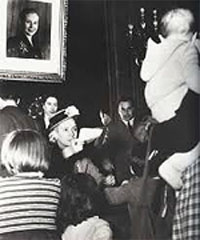 |
Evita Handing Out Checks |
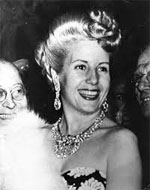 |
The Perón Wives - Evita (top) and Isabel Below |
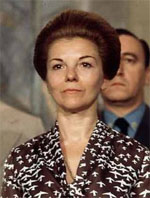 |
Juan Perón and his family, i.e., his wives (#1 - Eva Marie Duarte or "Evita" and #2 Isabel Martinez), would rule Argentina almost continuously for 33 years from 1943 to 1976.
Evita was born in the Pampas lands west of Buenos Aires (los Toldos) but moved to the capital when she was 15 (1930's). She became a successful actress attracting the attention of Senor Perón (then a Colonel and Secretary of Labor) and in 1945 they were married and, in 1946, he was elected president. Eva became Secretary of Labor and she then created her Social Help Foundation (officially, the Eva Duarte de Perón Foundation).
The Foundation started with 10,000 pesos (about $2,400 at that time) of Eva's own money. Eva convinced Juan to pass some laws that resulted in taxes and subsidies being diverted to the Foundation but an estimated 70% of it's funding came from companies and workers donations (with a good deal of pressure by the government to "donate"). When the foundation was disassembled in 1955, a reported 1.2 billion pesos were in the foundation's coffers.
Evita would die prematurely of cancer in 1952. Argentines, particularly the poorer classes would mourn Eva Perón as a saint and much would be written about her (including the Broadway Play - "Evita", which GG would see in 1981 - terrific singing and dancing). Evita had become immensely popular for her foundation when she sat in her Labor Secretary office and handed out checks to petitioners (see photo left). This popularity reflected on her husband who was greatly sympathetic to her wishes and would grant her whatever she wanted. After Evita's death in 1952, foundation activity declined and Juan began to lose favor, particularly with the military. Eventually the army and navy caused him to flee the country in 1955 and, in 1956, the 1853 constitution was re-established.
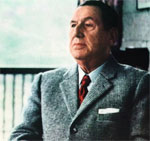 |
Perón at Age 77 |
Juan then married Isabel in 1960 and was elected president once more in 1973 but the next year, at the age of 78, he died. Isabel was elected to succeed him but was deposed by another military coup in 1976. A repressive military government led by Jorge Videla succeeded Perón and as many as 30,000 people were classified as having "disappeared" during this period.
The era of the Peróns had finally come to an end but the government would continue to be influenced by various Peronista politicos and military figures. Over time, the Peronistas would come in various political stripes and today are known as the Partido Justicialista, which also happens to be the party of the current president, Cristina Fernández de Kirchner.
In 1982, military troops were sent to invade the Falkland Islands (known as the Malvinas to the Argentines), which had been a British possession since 1833. But the British retook them only 10 weeks later. The defeat by the British is widely believed to be the cause of the downfall of the military dictatorship in power at that time. Following the fall of the military, in 1984 Argentina and Chile signed a peace agreement settling a long time border dispute. In 1987-88, several uprisings of the Carapintados (painted faces), a group of mutineers in the Argentine army, were put down. In 1989, hyper-inflation and political turmoil brought Carlos Menem, a Peronista, to power. He won a second term only after the constitution was changed to allow presidents to have more than one term.
The 1990's in Argentina were also a period of rising anti-semitism, although some believe this was a direct result of agitation by Iran. In 1992 the Israeli Embassy was attacked and 29 were killed. In 1994 the AMIA (Argentine Israelite Mutual Association) was attacked, killing 85. The struggle politically between the conservatives (by that time reconstituted as the Alianza) and the leftists (reconstituted as the Radical Party) continued throughout the '90's, the presidency and regional offices often trading offices between parties.
In 1992, Menem imposed peso-dollar parity to break the back of inflation. Indeed, it did that over the next few years but also ended up greatly reducing the country's ability to compete worldwide. This in turn created a large current accounts deficit that needed to be satisfied with new debt. There was also a significant outflow of capital and a depression ensued that resulted in the financial panic of 2001, accompanied by civil unrest throughout the country.
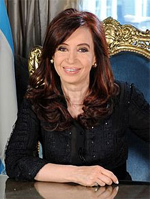 |
President Cristina What Me Worry? |
The crisis included a run on banks that was stifled by a policy called corralito (literally to corral or enclose into a small pen). The corralito almost completely froze bank accounts and forbade withdrawals from U.S. dollar-denominated accounts. This caused widespread demonstrations and protests that killed 26. Argentina officially defaulted on $93 billion of its debt to the International Monetary Fund and other creditors. Menem tried to run again but didn't make it.
In 2005 the current president, Cristina Fernández de Kirchner, who had been elected under the banner of the Judicialist Party (a branch of the Peronistas) cancelled debt to the IMF with a single, final payment but a U.S. District Court stopped the payment at the behest of the debtors. The funds had been provided by Distressed Equity Funds that Sra. Kirchner likes to call Vulture Funds because they actually want to be paid in full rather than 80 cents on the dollar.
 |
US$ per Argentine Peso |
Even the most casual observer, reading this brief Argentine history, would have to say that the country's history has been and continues to be tumultuous. The crisis is not over and the value of the Argentine Peso continues to decline (see graph right). Meanwhile, the "blue" market rate for dollars translates at 14+ to the buck while the official rate is 8.28. This is down (up?) from the 1 to 1 parity with the U.S. dollar in 2002 that was initiated during the hyperinflation of the late 1990's. But don't count them out just yet, Argentina has a long history of living from crisis to crisis and surviving.
In the middle of all this difficulty in modern politics and financial instability, Argentina won the World Cup in 1978 and again in 1986, making the loss in 2014 that much more difficult to bear by the Argentine public. There was even talk after the semi-final loss that president Cristina might be asked to resign (latinos take futbol very seriously) but evidently that has passed and she is holding on and so is their economy.
The Argentines have produced the most colorful, highest paid pro-futbol player in world history (Leo Messi), as well as the Queen of Holland and the current Pope. They are a vigorous people, not to be counted out regardless of economic conditions or who happens to be in power at any time
Political and financial crises notwithstanding, Argentina will prevail; it's in their blood.
¡Pura Vida!
Impresiónes de Buenos Aires
A Gringo-Tico In Crillolo Country
(Part 1 – The Trip Down and First Impressions of BA)
Researching Argentine history, or almost anything for that matter, is easy these days, thanks to the internet and Google, but nothing can replace on-site personal experience to get a flavor of the here and now. GG was lucky enough to visit Buenos Aires for 24 days in November and what follows is a simple commentary on what he saw and felt - a personal opinion. GG s original plan was to write this report in about 2,000 words after the visit, but BA, as the natives like to shorten it, does not lend itself to easy truncation and so I´ll try to fit the report into two parts over two editions, but forgive me if it takes three, the topic may require it.
(To get a brief history about the city and country, refer to the article above about the modern times in Argentina and for older history see History of Argentina - Part 2 the Columbian Period and Part 1 for pre-Columbian. Incidentally, the word “Crillolo” used in the subtitle is derived from Creole and used throughout Latin America to indicate someone who is a native of Latin America but not necessarily of Amerindian heritage. Criollo is a word that seems to be used with even greater frequency in BA.)
---
 |
The flight down was uneventful, as all good flights should be. We left on time from SJO and it was only one hour from Juan Santamaria to Panama City to meet up with the connecting flight to Buenos Aries. GG was a bit concerned with the 50 minute connection that he had booked, more so for the possibility of not seeing the bag in BA than missing the flight. A stewardess on board the Copa (Panama Airlines) flight told me we would dock at Gate 18 and the connection for Buenos Aires was at Gate 20 - schweeeeet thought the Golden One (the bag would have to pass through their mechanical system but GG would certainly make a two gate change).
The Golden One had been in Panama some four or five times but only in the North (David, Bocas del Toro, Boquete). I purposefully chose a window seat on the left side of the aircraft thinking it might get me a glimpse of the canal. Sometimes this old cranium still works well logically and I did get to see about half of the ditch plus many freighters in transit or waiting to go through. As a bonus I got a fly-by of the Miami-like city spread out along the coast. The airport seemed quite a bit south of the city center and, as we approached, the skeleton of a sizeable new terminal could be seen under construction on the north or west side of the airport (Panama is oriented.such that what I often think is North is really West).
We docked at Gate 18 as planned but the actual departure gate for Buenos Aires turned out to be #30, a hefty walk down the long concourse weaving in and out of the largest duty-free zone I have ever seen in an airport. Copa was kind enough to arrange a 45 minute delay in the BA flight so arriving at Gate 30 about 10 minutes before the originally scheduled departure time was not a problem. We left at 12:10 pm but would arrive only one minute late in Buenos Aires, according to the published schedule. That put us in at 9:17 pm (BA is +3 hours over San Jose, +2 hours over Panama and Miami), and just under 7 hours flying time from Panama City.
I had never flown Copa (Compañía Panameña de Aviación, or Panama Airlines) before but found them to be courteous and efficient. We were served a very nice complete lunch with a choice of entrees. GG was surprised when the flight attendant crew served scotch, whiskey, wine and beer gratis (that´s Latin for damn free). Where were these guys in the seventies and eighties when GG was frequently flying and imbibing. I kind of expected a full meal later on when they served the second meal but that turned out to be a sandwich instead, still quite good. But, again the free booze flowed.
There was little to see from the window on most of the flight down because the landscape below was almost completely covered by low hanging clouds. About one and a half hours before landing, sunset finally occurred and the clouds had cleared, revealing small and medium towns and cities lit up like electric starfish and well separated by large patches of blackness. We were flying and slowly descending over northern Argentina and obviously it was a big country.
 |
Main Hall BA Airport (EZE) |
Buenos Aires Airport is a large, modern aerodrome situated some 45 minutes by taxi southwest of the city. (There is a second airport, Jorge Newberry on the edge of town within the city limits which is used mostly for in-country and regional flights). One experience at BA airport was particularly of note: I have never processed through passport control and customs inspection faster than I did that night.
Part of this efficiency may have had to do with the hour we arrived but also I noted we didn´t have to fill out one of those irritating little forms that slow the lines, forms that I´m sure are inaccurate in most cases and later probably lost in the bureaucracy somewhere. At BA Airport simply show your passport with the reciprocity visa previously purchased online (a U.S./Argentina treaty requirement - $160) and throw your bag onto the x-ray belt at customs without intrusive inspection and, le voila, you´re into Argentina. BA airport lived up to its call letters: EZE.
My friend and host, Mike, was waiting for me outside customs and had kindly already purchased a special taxi that spirited us off to the center of the city where he and his partner have a three bedroom apartment on the 10th floor of a nine-story apartment building. The street level floor, as in Europe, is called “PB”, Planta Baja or ground floor (in French speaking countries it´s RC or Rez de Chausee - walking street) and is distinguished from the first floor which is the second floor in the U.S. of A. Now that we have made that perfectly clear…
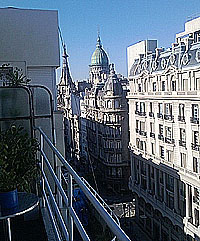 |
View from the Apartment |
My friend´s apartment building is one and a half blocks from the Congresso, the national congress building or parliamento (see photo left for the view from the apartment balcony). That copper clad dome in the background is the actual Congress building and a rallying point for what seemed to be an unending string of demonstrations that occur there or just start there.
The plan for the visit called for my friend and his partner to leave after a few days for a well-deserved vacation in the Caribbean. It was well-deserved because they had just moved into the new apartment from another location across town with all the anxiety that such a move creates and because one of them is a doctor (we would call him a GP or Internist) and someone, who I would come to see, works long hours. Vacationing in Sint Martin was beckoning and they heeded the call.
Despite his hectic schedule, my friend found time to give me the first tour of the city, or at least the part of it that included Cementario Ricoleta. This cemetery houses some of the most famous dead people in Argentina including Eva Perón or Evita as she was more affectionately known during her lifetime. Besides us, there was a steady stream of other live people, including tour groups and school students wandering the wide walkways between the crypts.
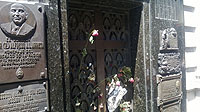 |
Eva Peron's Tomb |
The gate to Eva´s tomb is pictured to the left - note the fresh flowers that admirers still frequently place at the gate (she died in 1952). The tomb is actually the resting place of her family, the Duartes. I haven´t seen devotion like this since visiting Pope John XXIII´s grave site at St. Peter´s Basilica in the mid-1970´s (he had.died in 1963).
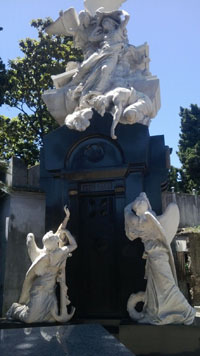 |
An Elaborate Mausoleum |
Other tombs, including many elaborate and obviously quite expensive mausoleums have names of the most influential families in Argentine history going back to the early days of Argentina. A photo of one of them is shown to the right
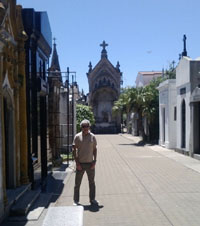 |
Mike Showing Me The Cemetery at Ricoleta |
I was particularly happy that Mike had taken me to this site because, for some reason, the city tour I took some days later did not bother to stop at this cemetery. The city tour did, however, as you´ll see later, hit many of the city´s highlights. Yet, the visit to Evita rounded out the total BA experience.
After the cemetery business and a brief stop at a department store so Mike could purchase a new dish drainer, the kind of thing that gets lost or destroyed during a move, we headed for the Puerto Madero area for lunch.
Puerto Madero is the public waterfront of Buenos Aries that runs along the Rio de la Plata from ferry terminals in the north (one of which I would take to Uruguay later) to an area about mid-town. There is a straight walking area more than a mile long that offers many restaurants and bars on the land side of the dike system (kind of like Savannah, GA). We had several dozen restaurants to choose from for lunch and ended up in one about 100 meters down the walking street.
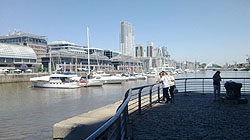 |
BA Port Area (Tourist) |
More will be described later about the food and restaurants in Buenos Aries but suffice it to say at this point that whatever you want is there, and in good quality and ample quantity.
In some places, like the waterfront and other tourist areas, it seemed more expensive in BA, even more so than Manuel Antonio, but off the beaten track it was much more economical. There is a definite accent of European cuisine and architecture, particularly Italian, that is nothing but good.
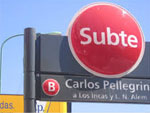 |
BA Subway (The Red Line) |
On the way back to the apartment, Mike helped me buy a rechargeable debit card for the subway (called the Subte or “soob-tay”) which I was to use frequently in the days to come. There are five major subway lines (blue, purple, light blue or aqua, red and green) that traverse the federal city of Buenos Aries and they can get you to most areas in a fairly short time.
I also learned later, by accident, that I can board the subway at the red line three blocks from the apartment (avenido Corrientes) for free because you can take an elevator for disabled (don´t qualify yet), elderly (edging on this one) and pregnant patrons (no comments on the rubber tire please) that somehow by-passes the ticket kiosk. I wasn't free-loading, it was suggested by a transit officer. Do I look that old?
First Impressions of Buenos Aries
It´s difficult not to be impressed when entering and viewing a city of some 3 million plus people (12-15 million more in the surrounding province). The size and scope of BA at first made me think of New York yet with more trees on virtually every street. Yet as I became more and more exposed to the area, my comparison changed to more like 70% Washington, D.C. and 30% New York. The taller office buildings are more like New York but the prolific number of architecturally interesting public and private buildings, monuments and museums resemble D.C. more.
About the City
Buenos Aries is a culturally rich city. The tourist map I used for three weeks listed 30 museums dotting the Federal District. I spent a pleasant two and a half hours visiting just one of them, the Museo de Bellas Artes (Fine Arts Museum) where there was no entrance fee and the collection of European Dutch, French, Italian and Spanish masters was second only to what I have seen at the Prado in Madrid or the Louvre in Paris.
 |
Avenue 9 de Julio, Buenos Aires |
The hustle and bustle of people walking everywhere in BA is like one finds in virtually all major cities. People dress more formally (Mike had pre-warned me that long pants are de rigueur in BA) and they seem more serious. They are really very careful, unlike Quepos, not to bump into you as you weave and bob through the stream of people on the sidewalk. Of course, the much wider sidewalks there also help and the strong stream of people encourage caution in that regard..
There are many sizable streets and avenues in BA, many of which run one way to alleviate traffic, which is thick in the day time; but two thoroughfares dominate the central district. These are Avenida 9 de Julio (photo left) and Avenida de Mayo which runs from the Congress area down to the Plaza de Mayo and into the Casa Rosada (the “Pink House” - the Argentine equivalent of the White House.
Avenue 9 de Julio is impressive in it´s grandeur. Traffic runs six to eight lanes in each direction with four more lanes in the middle reserved for buses. It fills up daily with traffic. Avenue 9 de Julio gets it´s name from the fact that the Republic was declared independent from Spain on July 9, 1836. The obelisk in the middle of the avenue commemorates the place where the first flag of independent and sovereign Argentina was raised.
 |
Don Quixoti and Evita |
While walking one day about mid-point of the avenue 9 de Julio, GG noticed a very artfully expressive statue of someone on a horse. Closer examination revealed it was a bronze likeness of Don Quixoti. When I looked over Don´s shoulder, I noticed a building on which had been constructed an outline of Eva Perón that lights up at night. I snapped the photo to the right. Interesting juxtaposition don´t ya think?
Another difference that is apparent when walking through the streets of Buenos Aires is the rather less homogenous look of the people as compared to Latin countries to the north. While black hair still predominates, there is quite a proportion of light colored hair, even blond; also an average skin color that is paler; and more eye color, including blue are not that uncommon. The mix of Spanish and Amerindian features is also not as prevalent in BA. The mix of physical characteristics of the people reminded me more of southern France and northern Italy, the latter not surprising since there was considerable immigration from Italy to Argentina in the 20th century.
Weather-wise, there is another difference. Unlike Costa Rica with two seasons, wet or “winter” (May 15 to December 15) and dry or “summer” (December-April), Argentina has the more common four seasons of a place well removed from the equator: Summer, (December-February - Hot and Humid; Fall (Warm days, cool nights, rainy season); Winter (June-August - Winter 1-3C (36-38F) at night;, 3-13C (37-55F) in daytime) and Spring (September-November – warm days, cool nights, some rain). GG was visiting BA at the end of spring. The first five days consisted of clear skies and warm, even a bit hot afternoons followed by cool evenings. The next three days were rainy and cool. The good weather then returned for the remainder of the visit.
Daylight at this time of year runs from dawn, around 5 AM, to sunset around 8 PM. That´s a 15 hour day as opposed to Costa Rica´s 12 hour days which remain almost the same all year long.
Money-Language
Getting used to the money system was interesting. These are inflationary times in Argentina. The rate of inflation is 25-40% depending on who is doing the calculation (25% is the government, 40% = the opposition; the truth is probably in the middle). This kind of inflation causes disruption in the use of money and unrest in the population and that is what is occurring.
U.S. dollars, still the most important medium for international trade, are in short supply and a black market (called “blue dollars” here) has developed that is what most people use in place of the official exchange rate. Inflation also fuels this market. The official rate (19 Nov) is 8.5 pesos per dollar while the blue rate is 13.5, a difference of 59%; obviously people want the blue rate. Mike had pre-warned me of this and he helped me exchange well on the blue market.
 |
Argentine 100 Peso Note |
Using the money takes a bit of getting used to. The largest denomination note is 100 pesos ($11.8 official, $7.4 Blue). One political wag that writes in an English daily there says that “the government limits the maximum size of the note as a denial of inflation”. The only coins are 1) one peso and 50/25/10/5 centavos; The coins below one peso, though exchanged in some transactions, are essentially useless as most transactions are rounded off to the nearest peso. Money changers can be found on any street, I presume for the benefit of tourists, but I didn´t need to use them thanks to Mike.
While the language is obviously Spanish, the dialect presents some new challenges for someone who basically is still learning the rudiments of Tico Spanish. One of the more interesting differences is the pronunciation of the double “l” or ll. In Costa Rica, a street is called a calle, pronounced ki-yah in English In BA it´s pronounced ki-zsa (like in Zsa Zsa Gabor). The street where Mike´s apartment is located is called Avenida Callao (ki-zsa-oh or, even better, ki-zshowe) with the emphasis on the second syllable.
The double ll sound is also the same in some instances for the letter “y”. Avenue de Mayo, the other best known avenue besides 9 de Julio, is pronounced Ma-zshowe. Then, of course, there is also an emphasis that is Italian; it´s not “Como tu vas, señor”; it´s “Como tu vaaas, senor” (difficult to describe in an English sentence but I think you get what I mean). I also heard a fair amount of what I would describe as a Latin-based discourse but with somewhat of a southern France twist; hearing Portuguese from Brazilians maybe?
During my three week visit I heard English spoken on the street or in the shops and restaurants maybe six times at most and four of those were with British accents.
Weather
The first five days were sunny and virtually cloud free most of the days. This produces cool, fresh mornings that slowly turn into warm mid-days and early afternoons. The town isn´t called “Good Airs” for nothing; there is an almost constant breeze that cools everything down even in the warmest times. In the city, the high-rises can accelerate the breezes and sometime they get strong enough to blow a cap off, something that happened to GG more than once. The seasons were described above.
Demonstrations
Here´s another thing that makes BA seem more like Washington. In the first week I was there we had four demonstrations that started at the Congress area and moved down Avenida Callao past the apartment. BA is a federal capital just like Washington and subject to demonstrations large and small. Drums, horns, loudspeakers and the occasional cherry bomb explosion reverberated through the cement caverns which are the buildings along the avenue. Many of the buildings are more than ten stories tall in that area.
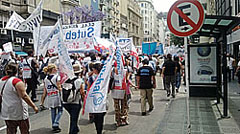 |
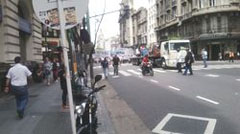 |
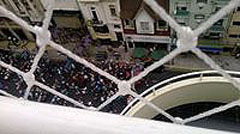 |
Demonstrations of Various Kinds Were a Common Occurrence in this Part of Buenos Aires |
||
What were the demonstrations about?. Well at least two of them, the Provincial Teachers Union and the Bank Workers Union had to do with the current economic situation. Currently there is a tax floor in the law – if you make less than 15,000 pesos per month (about $1,100), there is no income tax. But the problem with 25-40% inflation rates is that many workers are often edging that minimum and if a salary adjustment brings them over the threshold they can end up making less, even with a significant upward adjustment in wage rates. Naturally, they want to be protected from that kind of hit, hence the demonstrations.
One of the other two demonstrations that week was another small union whose name and purpose escaped me. The fourth and last demonstration was the annual Gay Pride parade; Argentina was the first Latin American country to legalize same-sex unions.
The country´s president, Cristina Ferdandez de Kirchner (photo in the article above), had been in the hospital with some kind of stomach ailment and remained there during most of my visit. When I asked a couple of workers (a taxi driver and a waiter on a tour boat) if she was getting better; they both blew me off, the taxi driver also offering that “She´s not very popular”. Maybe that´s the source of the ailing stomach.
During the second week, we had a few days of rainy and colder weather which may have dampened planned demonstrations. But 10 days into my 23 day stay, I was making some dinner when the noise struck up just below the apartment building. I went down to the street level to see what was going on and approached the small crowd in front of the Hotel Savoy next door with caution (who knows how angry they might be). Turns out it was simply a rally for a football team that was staying at the Savoy. Go blue!
After a few days my host was off to the Caribbean and I was on my own except that I was entrusted with Teddy the cat. Teddy and I became instant buddies. I think I´m beginning to speak meow-meow, but with an Argentine accent.
There is much more to report including a guided tour of the city, a tour of the delta area to the north near La Tigre and a tour of Montevideo, Uruguay plus more encounters with interesting people and places in Buenos Aires.
But that´s for next month and Part 2.
SJDS Redux
(Revisiting San Juan del Sur, Nicaragua)
GG first visited Nicaragua in July 2009 on a visit to Granada on Lake Nicaragua about an hour north of San Juan del Sur. At that time the pleasure trip was combined with a need to obtain a 90-day Costa Rican visa renewal. Ah, nostalgia for the pre-cédula days! While I don't miss the process of getting residency in Costa Rica, it did provide a regular reason to get out of Dodge for a while.
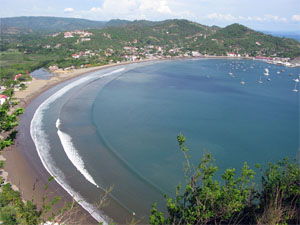 |
View of San Juan del Sur from the Cristo Misericordia Statue |
GG returned to Nicaland in March of 2014, that time with cédula in hand but with the specific purpose of checking out San Juan del Sur on the country's south Pacific coast, a resort area often talked about in international circles. This year, GG was invited to attend an international men's retreat in San Juan and couldn't resist the opportunity to go back to this very pleasant resort town.
Getting there was a bit arduous. On previous visits to Nicaragua, GG had taken a bus to San Jose the previous day (3 hours), stayed overnight and taken a bus (Ticabus or Nicabus (8-9 hours) to and through the Costa Rica/Nicaragua border to a town called Rivas. Rivas is a town of great historical significance to Ticos because it's where its favorite hero, Juan Santamaria, for whom the main San José airport is named after, defeated the American filibuster William Walker). From Rivas, we took a taxi to San Juan (~1 hour). Total riding time 11-12 hours. Technically we could have made it from Quepos in one day if we had taken the 4 AM directo to San José but that's even more grueling.
On this trip we decided to try going directly north to avoid diverting through San José. This involved a bus to Puntarenas which takes 3 hours but actually this time a friend was going that way and drove us to Puntarenas, We took the bus on the return. Then we took a bus from Puntarenas to Liberia (3 hours), then a bus from Liberia to the border (1-1/2 hours), then a taxi to San Juan (~1 hour). Total riding time: 9-10 hours, a saving of a couple of hours versus the San José route. The Puntarenas and Liberia bus connections were quite convenient with departures every 30-45 minutes throughout the day.
We stayed in a small hotel called La Dolce Vida in the center of the town. The town seems a bit smaller to me than Quepos but web sources say San Juan del Sur has a population of 15,500 versus 11,000 in Quepos. The location is very convenient to much of downtown SJDS and you can walk to the bay in about two blocks. The hotel was basic, but was comfortable (AC/TV) and we didn't argue with a total bill of $150 for two people for three nights. The staff was also quite friendly and helpful.
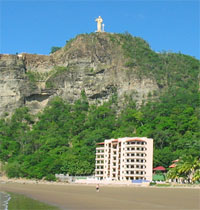 |
Cristo Supervising the Beach and the Town |
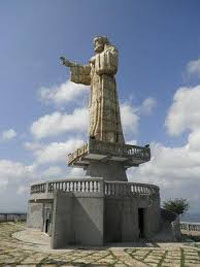 |
Close-Up of Cristo Misericordia Statue |
Our meetings were held at two private homes on the mountain that rings the bay south of the town. The two locations, one on the south side of the mountain and the other on the north side have one thing in common: the view from both is dominated by an 26 meter (85 foot) statue of Cristo de la Misericordia (Christ of Mercy or Christ the Merciful). The statue is similar to Christ the Redeemer statue in Rio de Janeiro but about 4 meters or 14 feet shorter. Nevertheless it is an impressive statement in such a small town and dominates the skyline.
For the trivia buffs like GG among us, the statue in San Juan del Sur is one of 21 statues of Christ around the world that are over 20 meters in height. It was surprising to me that the statue in Rio ranks only as #4 in the world in height and the one in San Juan del Sur is #11.
So where is the tallest one? It's in Cochabamba, Bolivia and comes in at 34.2 meters or 112.2 feet. It's followed by one in Świebodzin, Poland (33m/108f) and Vung Tau, Vietnam (32m/104f). Then it's Rio de Janeiro, Brazil; Palencia, Spain; Manado City, Indonesia; Tlalnepantla. Mexico; Lisbon, Portugal (don't remember that one - must have been drinking at the time); Dili, East Timor; Cali, Columbia and then San Juan del Sur.
Our group also met informally for dinner a couple of times at the El Timon restaurant on the bay. We reviewed this restaurant on a previous visit. To see the review go here: El Timon. It was a great weekend in many ways, thought provoking discussions and good camaraderie amongst some breathtaking scenery in a beautiful part of Central America.
Our activities during the weekend kept us busy enough that GG did not get to visit some of the other beaches north and south of San Juan, something he also missed doing on his first visit. Sounds like another trip to SJDS will be required to complete this oversight.
¡de acachimba! (Nicaraguan, sort of like ¡pura vida! to a Tico)
Travel Quote of The Month |
|
What's-in-a-Word
Cachete
Spanish slang for chubby cheek, one could also say moflete. Cachete also is used for "slap", as in punch: Darse de cachetes con alguien is to fight with someone.
Dollar and Dollar Sign - $
Here's one that caught GG by surprise.
 |
How the Peso Became the U.S. Dollar |
When GG was preparing for his trip to Buenos Aires and looking at some possible tours he noticed that the price of some of these tours seemed outrageous. A one day boat trip across the Rio de la Plata from Buenos Aires to Colonia, Uruguay and back was quoted at $250 (and it stated lunch was on the tourist!). As a gringo, I have assumed all along (there's that nasty word again) that the $ sign was a symbol invented by America. It turns out that the first use of this symbol was by the Spanish.
Some believed that the $ symbol came from the figure 8 representing the Spanish piece of eight. But records show it came from the shorthand for "ps" which stands for peso. It first appeared in the U.S. in the 1770's in written form in documents from English-American traders who were dealing with the Spanish.
The written word "dollar" comes from the Flemish or Low German word daler (in High German, taler or thaler), referencing a specific coin minted from the silver mines of Bohemia. The term was later applied to a coin used in the Colonies, both Spanish-American and British North American, at the time of the American War of Independence. It was later adopted by Congress as the official unit of the U.S. currency.
The official Argentine Peso/U.S. Dollar exchange rate at the moment is about 8.5 P/$ and the black (blue) market rate is about 14. That makes the tour rate of $250 more like $18-31 U.S. dollars. That's better for the budget, thank you very much.
Pez Vela
Pez = fish and vela = sail, so pez vela = sailfish. So the Quepos Marina is the Sailfish Marina. But if the fish is dead such as it being cleaned in preparation for cooking, it's called pescado instead of pez. Derived from the verb pescar, pescado is the past particle. Makes some sense, a dead fish has definitely been "fished".
¡Que Bueno, Amigos!
ROMEO Corner
(Retired Old Men Eating Out)
Tin Jo, San José
Location: Calle 11, av. 6-8 (that's one block east of the entrance to Chinatown and about two blocks south. The restaurant suggests the following directions for taxis: "De la Casa del Tornillo, 100 este, 125 norte (ah, the inscrutable Costa Rican address system; that sounds like 100 meters east and 125 meters north of the "Screw House", you know, like in flathead or phillips)
Hours: Mon-Thurs: 11:30A-2:30P & 6P-10P; Fri-Sat, add one hour to closing time; Sun: 12-9P
Parking: Not offered by the restaurant; find a lot or space on the street.
Contact: Tel.: 2221-7605 & 2257-3622; Email: from Website; Website: http://www.tinjo.com/
Reviewing ROMEOS: Bob N.
To Review Our Rating System and Procedure, go here: R.O.M.E.O. Rating System
Finding himself in San José on assorted business once more, GG decided to renew acquaintance with this restaurant which he had tried a few years earlier.
This is a favorite eating emporium among Josefinos (also called Chepeños and both meaning someone from San José - see What's-in-a-Word above), very busy both at lunch and dinner. GG walked in early for dinner (about 6) and over half the tables were tagged with reserved signs.
 |
Tin Jo Entrance |
The exterior of Tin Jo is very unassuming and located on a not so busy street (see pic left). But the charm of the place hits you quickly once through the front door.
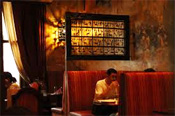 |
1 of 3 Dining Rooms |
GG was ushered into one of the three dining rooms, the one pictured to the right. Soft beige and burgundy tones permeated all aspects of the room and its decorations. The subdued, but not dark, lighting enhanced the effect and immediately made one comfortable. The walls were artfully painted to enhance the rough stone surfaces with tasteful scenic designs. There was even a small table with a large bowl of colored water containing candles. I was told this was to ward off evil spirits (I must say none appeared during the meal). It would be hard to not give Tin Jo five sloths for atmosphere.
Tin Jo is not a Chinese restaurant, it is an Asian or Asiatic restaurant offering cuisine from China, Thailand, Japan, Philippines, Vietnam and India. The menu is extensive, offering Thai and Indian curries, grilled beef, chicken and pork specialties with flavor accents from Japan, Philippines, Indonesia, China and Vietnam. There are also a variety of vegetarian and gluten free dishes and even pastas and chop suey for those that insist on them.. GG chose a Thai dish called Pad Krapao with shrimp. The vegetables were fresh and crisp ("au point" say the French), the shrimp were tender and the sauce was light but elegant; a subtle and slightly spicy translucent concoction with a hint of basil. The combination was delicious. For dessert GG chose another Thai concoction called Khao Neao, a rice and mango combination in coconut milk that also was delicious. |
 |
|---|---|
$$$1/2 |
|
Value Index = 4.5/3.5x100= 128 |
For food quality we have to give Tin Jo five sloths also.
Service was friendly, attentive and helpful, good for four to four and a half sloths at least, giving the restaurant an overall rating of five sloths.
The bill for the main dish, dessert, one coke and one cup of coffee was less than 14,000 colones ($26). GG expected more because he failed to see the bottom of the menu that says sales tax (13%) and mandatory gratuity (10%) were included in the menu prices. This puts Tin Jo a significant distance from the pricier restaurants in San José (and Manuel Antonio) and we give the restaurant a 4$ rating. That results in a Value Index of 5/4x100=125 putting it in the top third of restaurants so far reviewed.
If you're looking for a change of pace and like asian food, be sure to try Tin Jo the next time you're in San José.
A narrative version of the Golden Gringo Chronicles is now available as a trilogy of E-books in formats compatible with virtually all electronic platforms. Click on Part Number above for E-book sample downloads or click the price above right for purchase. (The best price is on Part 1; it's FREE)
The story of the Golden Gringo Chronicles is also available as a hard copy novel of 192 pages available through Amazon and all major online retailers. ($9.95) Amazon link: GGC, the Book. (Kindle Edition available) Follow GG through the first six years of his odyssey in making the decision to retire in Costa Rica, overcoming the trials and tribulations of moving and obtaining residency there and the fun and experience of actually living in Ticoland. Ride along with the Golden Gringo as he learns about the rich, varied culture of Costa Rica, the incredible bio diversity, the charming nature of the Costa Rican people and the ease with which a sometimes clueless ex-pat can assimilate into a small southwestern town on the Pacific coast. Whether you are already a Costa Rican resident, someone contemplating a move here or just a traveler who enjoys different cultures, you will find the Golden Gringo Chronicles interesting, entertaining and informative about Costa Rica. |
don Beto de Quepos,
El Gringo Dorado Pura Vida! |
Be pithy but kind. I'm sensitive. |
|---|













